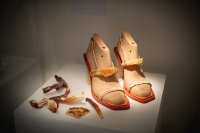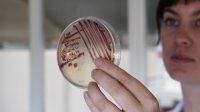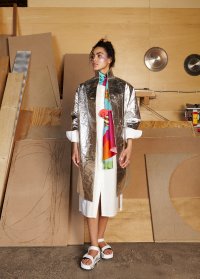1. Alternative materials

Shoes made of fungi leather
Synthetic fabrics make up an estimated 63 percent of all textiles produced globally in any one year. These fabrics, such as polyester, nylon and acrylic, are based on fossil fuels. Washing them releases a lot of microplastics that end up in the oceans. And large amounts of CO2 are released when the synthetic clothing is incinerated at the end of its life.
An alternative is to make clothes from natural raw materials such as cotton, linen, wool and silk. ‘Those materials are in principle CO2-neutral and don’t release microplastics,’ says Jan van Dam, expert in biomaterials at Wageningen Food & Biobased Research. But the downside is the amount of land, water and pesticides they require. For example, producing one kilo of cotton takes 10,000 litres of water on average, and chemical pesticides are used in large quantities by non-organic cotton farmers. Silk production affects the climate because it costs a lot of energy to grow the food for the silk caterpillars (mulberry leaves). Then there is the animal welfare aspect, as the caterpillars are boiled alive. Bamboo is sometimes cited as an alternative. Bamboo cultivation is sustainable but turning it into textiles still uses a lot of energy and chemicals, explains Van Dam.
In the Bio2HighTex project, Van Dam and his colleagues are investigating the potential of flax and hemp as raw materials for textiles. These crops need less water and growers use less pesticide. At present, hemp fibres are mainly incorporated in construction materials and lightweight car parts but Van Dam says they are also suitable for the textile industry. ‘This is already being done on a small scale but the technology is still in its infancy. Processing the three-metre stalks is labour-intensive and the hemp needs to go through numerous processing steps before you get yarn.’ The researchers are looking at how they can improve this process and how farmers can grow hemp for the textile industry in a financially viable way. Van Dam: ‘For example, you could harvest the plants earlier when they are smaller, which makes processing easier.’
The researchers are also looking at ways of producing clothing from bioplastic. ‘If you ferment sugar cane and starch products, for instance, you get the bioplastic polylactic acid,’ explains Van Dam. That polylactic acid could replace polyester.
Some scientists are going even further in experimenting with new materials. Iris Houthoff, lecturer in Bio Process Engineering, has created shoes made from fungal leather. She is working with designers and scientists in the Plant Breeding Group in particular on this new material, called Mylium. The fungi grow on waste products and cultivating them requires little water or chemicals. ‘The shoes are also entirely biodegradable,’ says Houthoff. ‘They are not yet suitable for wearing but they do at least show where we are heading.’
2. Alternative dyeing techniques
Dyed, bleached or stonewashed clothes look good but they are definitely not good for the environment. The bleaches, acids, inks and dyes that are required are responsible for 20 percent of all global industrial water contamination.

Ilfa shows bacteria that can be used to dye fabrics pink
Chemical dyes can be partly replaced by natural dyes made by algae and bacteria. ‘Some microalgae produce a blue colour that is already used in sweets,’ says Ben van den Broek, a researcher at Wageningen Food & Biobased Research. He collaborated with WUR students and the designers Laura Luchtman and Ilfa Siebenhaar on the Living Colours Project, one of the academic consultancy training (ACT) projects in the Circular Fashion Programme run by WUR and ArtEZ Centre of Expertise Future Makers. Van den Broek: ‘The disadvantage at the moment is that the colours don’t bind well to the fabric, which means they fade quickly.’ The scientists are looking for ways to produce the dyes on a large scale at affordable prices and are investigating how to get a more colour-fast result that survives the washing machine.

Aliki van der Kruijs dyeing Louise Fresco’s dress with waste ink
The colours themselves can also be recycled. Designer Aliki van der Kruijs uses waste ink as a dye. ‘Inkjet printers are used to dye fabrics. The printheads are sprayed clean in between every time to prevent streaking. I got inspired when I saw the lovely deep purple colour of the ink remains on the side of the printer.’ That ink currently ends up mostly as chemical waste but Van der Kruijs says it could also be reused. She used waste ink to dye the dress that WUR Executive Board president Louise Fresco wore to the opening of the academic year.
3. More recycling
The clothing industry is a long way from a circular economy: only 1 percent of all clothing is reused to make new clothing. 14 percent ends up as insulation material, cleaning cloths or mattress stuffing and the remaining 85 percent is incinerated or dumped in landfill sites.
Van Dam sees the encouragement of reuse as crucial in making the fashion industry more sustainable. While recycling textiles also involves energy and water, the overall environmental impact is less than the production of fabrics from new materials.
One form of reuse is mechanical recycling, whereby clothing is picked apart and spun to create new yarns. This method is used to turn denim jeans into insulation material, for example. Synthetic textiles such as polyester can also be chemically recycled. Van Dam: ‘However, at the moment chemical recycling is more expensive than extracting the material directly from petroleum. People are currently working on upscaling the process to make it cheaper.’
Van Dam would like to see much more use being made of the fibres in old clothing to produce high-quality material for new clothes. ‘The disadvantage is that recycled fabrics tear more easily because the fibres are already damaged.’ Another problem is that most items of clothing consist of a mix of materials, such as synthetic fabrics and cotton. That makes recycling more difficult. ‘We are therefore working with our supply-chain partners to look at ways of recycling mixed textiles such as denim and T-shirts,’ says Van Dam.
Second-hand clothes
are best for the environment as they don’t involve any factory processing. ‘But you do then need someone to be buying the second-hand clothes as a replacement for new clothing and not as an extra,’ says Judith van Leeuwen from Environmental Policy. Together with students from various Master’s programmes, she carried out a survey in Porto, Portugal. Around half of the city’s residents who were surveyed bought second-hand clothes sometimes. Those purchases were to replace new clothes in 69 percent of the cases. However, the analysis also showed that there are still problems with the recycling process. Van Leeuwen: ‘Only 20 percent van the clothing that was collected and resold came from Porto itself. A lot of the second-hand clothing is imported and exported.’ That requires transport, which harms the environment.
Van Dam acknowledges this. ‘Many countries collect clothing for recycling or second-hand sales but then export the clothes to countries that often don’t have their own infrastructure for recycling.’ That means these clothes may be used one more time, but then they still end up on a rubbish dump. Van Dam: ‘Meanwhile, less and less clothing is going to countries in Eastern Europe and Africa, in part because of the competition with the local textile industry and also because living standards are rising there. What is more, some manufacturers don’t want to sell their fashion-label clothes at knockdown prices as that makes the product seem less exclusive and luxurious. So whatever doesn’t get sold in their collection gets incinerated instead.’ The British fashion label Burberry caused a furore this summer when it destroyed more than 30 million euros’ worth of clothes.
4. More aware consumers
In the first 15 years of this century, global sales of clothes doubled to reach 100 billion items in 2015. Consumers own more and more items of clothing and get less wear out of each item. So consumers need to change their behaviour if the fashion market is to become more sustainable.
But that is easier said than done, says Arnout Fischer, researcher in the Marketing and Consumer Behaviour chair group. ‘People say they find sustainability important but you don’t usually see that reflected in what they buy.’ According to him, this discrepancy is seen everywhere in the market. ‘Everyone has principles, but once in the shop you forget about that and generally go for the quick and easy option. We are surrounded by disposable fashion so you would have to be highly motivated to shop based on your principles.’ Everyone buying a bit less sounds like a good solution but Fischer does not see that as particularly feasible. ‘It so happens that we are used to a lot of choice. Your clothes are a statement about who you are and your social status. Keeping up with the latest fashion is part of that, just like some people have to have the latest iPhone.’
Manufacturers who want to successfully market sustainable products are best off focusing on added value for the consumer, says Fischer. Some second-hand clothing, for instance, is sold as exclusive ‘vintage’ clothes. Fleece is praised for being nice and warm and fast-drying, not because it is made from recycled polyethylene terephthalate bottles.
Fischer thinks trying to educate consumers makes less sense. ‘Processing that information costs them time and effort. And what do they get in return?’ That is why he feels labels that stress the sustainability of the product have little effect. ‘Less than 5 percent of consumers look at the labels when they buy something.’ Although that doesn’t mean the labels serve no purpose at all. ‘Labelling can help shift the minimum standard in the market. You see that with the “Better Life” label and free-range eggs: they started off as distinctive but are now more or less the norm. That’s happening in the fashion industry too, for example with organic cotton.’
Circular Fashion Lab

Kim Poldner
WUR has set up the Circular Fashion Lab to bring together designers, public authorities, scientists, students and companies to consider ways of making the fashion industry fairer, cleaner and more sustainable. ‘The industry has done a lot over the past 20 years to become greener but there are still many problems,’ says Kim Poldner, researcher in the Management Sciences group and coordinator of the Circular Fashion Lab. ‘The current production process is linear: clothes are produced, worn a few times and then discarded. If we are to get a truly circular economy in the clothing industry, we have to collaborate to create a new system.’
Pineapple jacket

A jacket made of Pinatex, textile made of pineapple leaves
Starting this week, mini-exhibitions are on show around campus with actual examples of circular-economy fashion, such as a jacket made of pineapple leather and clothes dyed with algae or bacteria. The Spot is also focusing on the ethical side of the rag trade, challenging consumers to think about where their clothing comes from with the slogan ‘Who made my clothes?’

